Evolutionary Ecology, Behavioural Ecology, Sensory Ecology, Acoustic Communication, Mating systems, Nuptial gifts, Genitalia
Model organisms: Insects: bushcrickets (Ensifera: Tettigoniidae), grasshoppers (Caelifera), acoustic orienting parasitoid flies (Tachinidae: Ormiini)
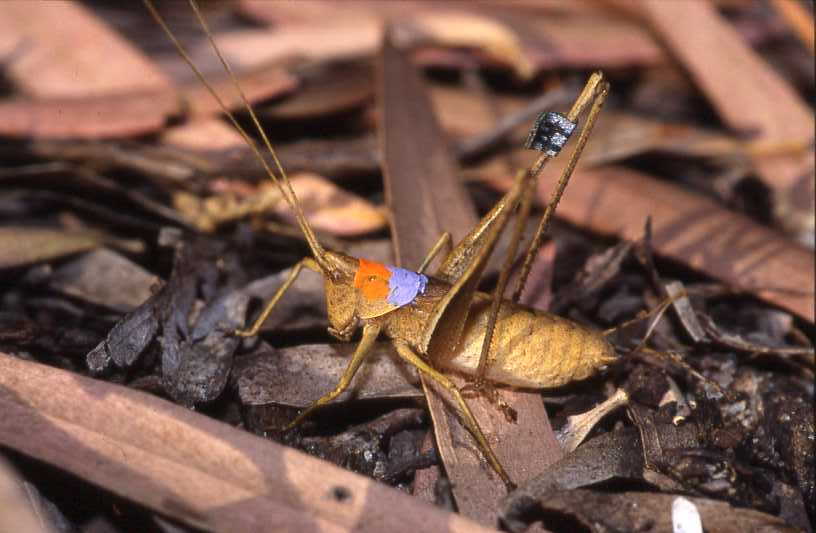
 Kawanaphila mirla male
Kawanaphila mirla male
Xederra charactus male marked for experiment (used for Lehmann 2007) The tiny australian Kawanaphila mirla - a green male (see Lehmann and Lehmann 2007)
Male genitalia and female mate choice bushcrickets
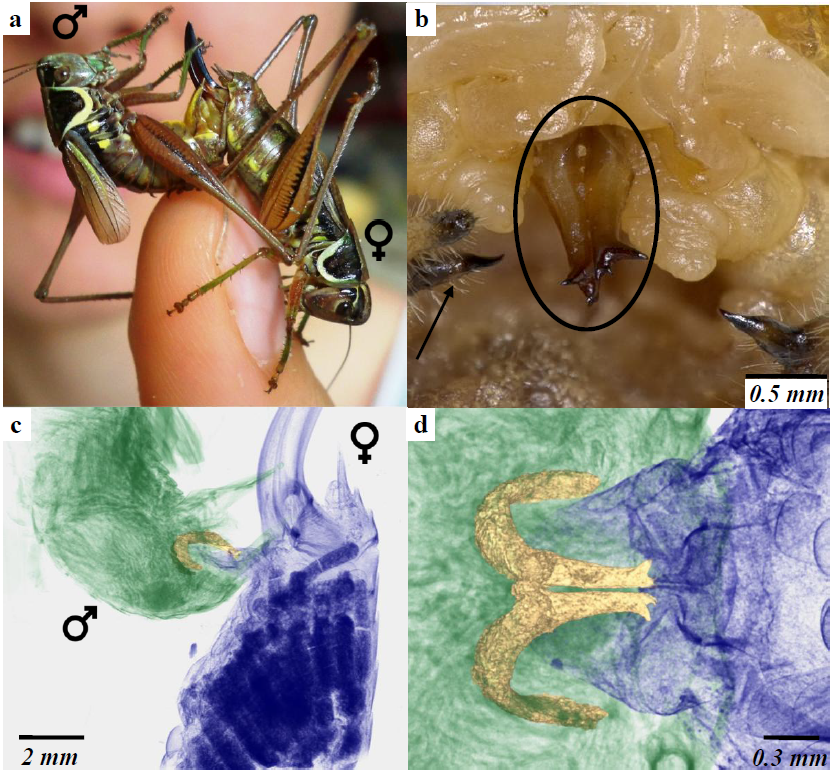 Bushcricket titillators in Metrioptera roeseliiAnimal genitalia are highly diverse in structure and function and assumed to be evolved under sexual selection (Eberhard & Lehmann 2019). However, the selection pressures shaping these structures are unclear for most genitalia. In bushcrickets males grasp the females for mating with their cerci. Many species also possess internal genitalia, the titillators. Comparing data from 54 species, copulation duration was influenced by the present-absence of internal titillators. Copulation duration increased with spermatophore size in titillator possessing species, but not in those without (Vahed et al. 2011). However, titillator complexity did not correlate with copula duration. In opposite to sexual selection theory, the comparative data failed to find an influence of the level of polyandry on bushcricket titillator complexity (Lehmann et al. 2017).
Bushcricket titillators in Metrioptera roeseliiAnimal genitalia are highly diverse in structure and function and assumed to be evolved under sexual selection (Eberhard & Lehmann 2019). However, the selection pressures shaping these structures are unclear for most genitalia. In bushcrickets males grasp the females for mating with their cerci. Many species also possess internal genitalia, the titillators. Comparing data from 54 species, copulation duration was influenced by the present-absence of internal titillators. Copulation duration increased with spermatophore size in titillator possessing species, but not in those without (Vahed et al. 2011). However, titillator complexity did not correlate with copula duration. In opposite to sexual selection theory, the comparative data failed to find an influence of the level of polyandry on bushcricket titillator complexity (Lehmann et al. 2017).
Within the species Roeseliana roeselii, experimental titillator manipulation revealed the adaptive function of this structures, which reduces female resistance and allowed the undisturbed transfer of the spermatophore (Wulff & Lehmann 2016, 2020). Cryo-fixated couples in copula were examined using microscopic computer tomography to study the position of this internal genitalia (Wulff et al. 2015). Scans using synchrotron life-videos from copulating pairs support a copulatory courtship functioning of the titillators inside the female (Wulff et al. 2017). Titillators are under sexual selection, as titillator size is positively correlated with male body size (Lehmann et al. 2021b).
Neurophysiology, neuroanatomy and sensory ecology of hearing in bushcrickets
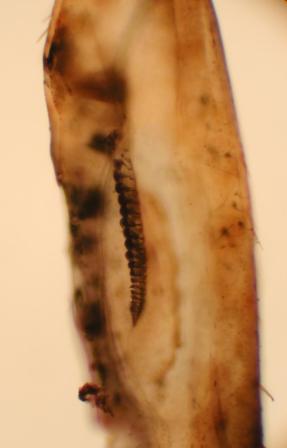 Poecilimon ampliatus - backfill of the Crista Acustica
Poecilimon ampliatus - backfill of the Crista Acustica
The bushcricket genus Poecilimon is species-rich and contains more than 120 named species in the Western Palaearctic Region. As common in the whole subfamily of Phaneropterinae, most species have a bidirectional communication system: males produce calling songs, which are replied by their females with own, short response songs. Independently, several species have returned to an unidirectional mode, in which the silent females lost their ability to sing. The morphological arrangement of the nerve cells in the hearing organ "Crista Acustica" is highly variable between species (Strauß et al. 2012). Furthermore, the neurophysiology and neuroanatomy of the hearing organs are altered in line with the changes in the communication system (Strauß et al. 2014).
Unisexual reproduction is a rare but widespread phenomenon in invertebrates and lower vertebrates. This holds true even for bushcrickets, were only few cases of obligate dipoloid parthenogeny are known (Lehmann et al. 2010b). Traits under relaxed selection are expected to become reduced or disappear completely, a process called vestigialization. The bushcricket Poecilimon intermedius is one of the few insect species with obligate but diploid parthenogenetic reproduction.
Compared to its sister-species P. ampliatus, the morphology of the hearing organs (acoustic spiracle, crista acustica) and the function of hearing (acoustic threshold) are reduced. Nonetheless, hearing is clearly maintained in the parthenogenetic females. Natural selection by acoustic hunting bats, pleiotropy or a developmental trap may explain the well maintained hearing function (Lehmann et al. 2007).
In cooperation with Dr. Johannes Strauß, Justus-Liebig-Universität Gießen.
Longtime monitoring of biodiversity using autonomous acoustic sensoring systems (EU Project AmiBio)
The AMIBIO project aims to construct and deploy autonomous multi-sensor monitoring stations and to automatically analyze their transmitted measurements for long-term monitoring of biodiversity activity trends in the region of the Hymettos, Greece.Within this EU financed Life+ project we monitor the occurrence of acoustically active birds, mammals and insects in the Natura 2000 area Hymettos, east of Athen, Greece (Jahn et al. 2011, 2012; Lehmann et al. 2014). 16 remote monitoring stations sample the acoustic activity of the animals. All stations are solar powered and transfer their data to a central computer. This allows for cost effective monitoring of biodiversity data. The software for automatic species identification is under way. We also hope to improve databank management of acoustic biodiversity data within the framework of this project.
The project is part of the EU initiative Natura 2000, to safeguard Europe's rich diverse natural habitat.
In cooparation with Zoologisches Forschungsmuseum Alexander-König, Bonn, University of Patras, University of Athens, SPAY: Association for the Protection and development of Hymettos.
Chromosome evolution and sex determination in bushcrickets
We study the patterns of chromosome evolution in the European bushcrickets of the subfamily Phaneropterinae using classical NOR- as well as FISH-staining (Warchalowska-Sliwa et al. 2013). The data on chromosome modifications are compared with a molecular phylogeny of the Group (Grzywacz et al. 2018). Studying the southwest Mediterranean genus Odontura in more detail, we found an intensive evolution of the karyotype, both in terms of changes in the number of chromosomes and the sex chromosome system. The basic pattern is an XX-sex determination in females and X0 in the heterogametic males. However, males of two species have evolved a Neo-XY or a neo-X1X2Y pattern in their sex chromosomes (Warchalowska-Sliwa et al. 2011; Grzywacz et al. 2014). This new evolved sex chromosomes in the males can be expected to have fundamental consequences for sex-chromosomal inherited traits as well as selection due to mate choice.
In cooparation with Prof. Dr. Elzbieta Warchalowska-Sliwa and Dr. Beata Grzywacz, Polish Academy of Sciences, Poland.
Nuptial gifts
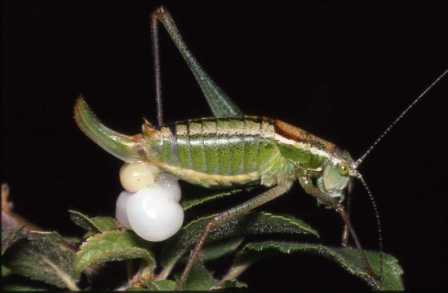 Poecilimon thessalicus - female freshly mated with huge spermatophore
Poecilimon thessalicus - female freshly mated with huge spermatophore
Some species provide nuptial gifts during mating towards their mates (Lewis et al. 2014). In bushcrickets, males of most species transfer a huge, which mainly act as sperm protection device (Lehmann 2012). However, the spermatophylax is nutrient rich, especially in nitrogen, and replaces female food intake over the short term (Lehmann and Lehmann 2016). Ingredients in the spermatophore (Lehmann et al. 2017) are incorporated by females into the somatic tissue (Voigt et al. 2006) and fuel the female metabolism (Voigt et al. 2008).
Heavier males of Poecilimon zimmeri transfer larger spermatophores (Lehmann and Lehmann 2009) and females exhibit clear choice for heavier males in mating trials (Lehmann and Lehmann 2008a). Such preferences for heavier males reflects a female's preference for a larger spermatophore and therefore for a greater direct benefit.
In line with the hypothesis that spermatophore production is costly, we found that spermatophylax weight was reduced in parasitized bushcricket males (Lehmann and Lehmann 2000a). Parasitized males with a smaller spermatophylax induced a reduced refractory period in females. During this shortened period fewer eggs were deposited, as an effect of the shorter refractory period, whereas the daily egg-laying rate remained the same (Lehmann and Lehmann 2000b).
Parasitoid flies- Ormiini
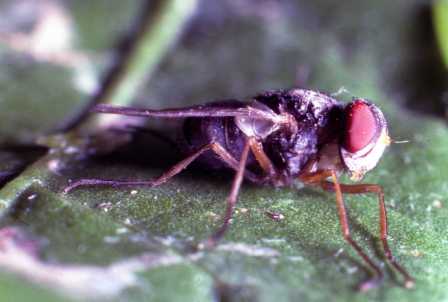 Therobia leonidei - female parasitoid flyTachinid flies of the tribe Ormiini possess a conspicuously inflated prosternal region, enabling them to detect the mating songs of their hosts (Lakes-Harlan and Lehmann 2015, Lehmann and Lakes-Harlan 2019). The only European Ormiini representative, Therobia leonidei, attacks the singing sex of three different families of bushcrickets (Lehmann 2003, Lehmann 2008). In populations of the Greek phaneropterine bushcricket Poecilimon mariannae males, which produce long calls, were found to be parasitized in large proportions. In contrast, Poecilimon veluchianus produces short calls and is less parasitized (Lehmann and Heller 1998), proving that longer songs are easier to detect. Moreover, male calls that are more attractive to females are also more attractive to parasitoid flies (Lehmann et al. 2001), suggesting a trade-off between sexual and natural selection.
Therobia leonidei - female parasitoid flyTachinid flies of the tribe Ormiini possess a conspicuously inflated prosternal region, enabling them to detect the mating songs of their hosts (Lakes-Harlan and Lehmann 2015, Lehmann and Lakes-Harlan 2019). The only European Ormiini representative, Therobia leonidei, attacks the singing sex of three different families of bushcrickets (Lehmann 2003, Lehmann 2008). In populations of the Greek phaneropterine bushcricket Poecilimon mariannae males, which produce long calls, were found to be parasitized in large proportions. In contrast, Poecilimon veluchianus produces short calls and is less parasitized (Lehmann and Heller 1998), proving that longer songs are easier to detect. Moreover, male calls that are more attractive to females are also more attractive to parasitoid flies (Lehmann et al. 2001), suggesting a trade-off between sexual and natural selection.
These flies lay their larvae on or near males; the larvae burrow into the cricket’s body, feed on the tissue and kill the animal upon emergence (Lehmann 2006). Developing fly larvae reduce male bushcricket survival and reproductive effort (Lehmann and Lehmann 2000a, 2000b). Parasitized males loose 42% of their potential lifetime reproductive success (PLRS) compared to nonparasitized males. This fitness loss is context dependent; if nonparasitoid related mortality is high, the selection on host males to avoid parasitism is weak (Lehmann and Lehmann 2006).
Opportunities for Students
Students are welcome to do their degree projects (Bachelor, Master or PhD) in the Department of Biology. Potential students are encouraged to take part in ongoing research projects. However, I am willing to discuss independent ideas. Those who are interested are advised to contact me at gerlind.lehmann (at) biologie.hu-berlin.de or gerlind.lehmann (at) nabu.de
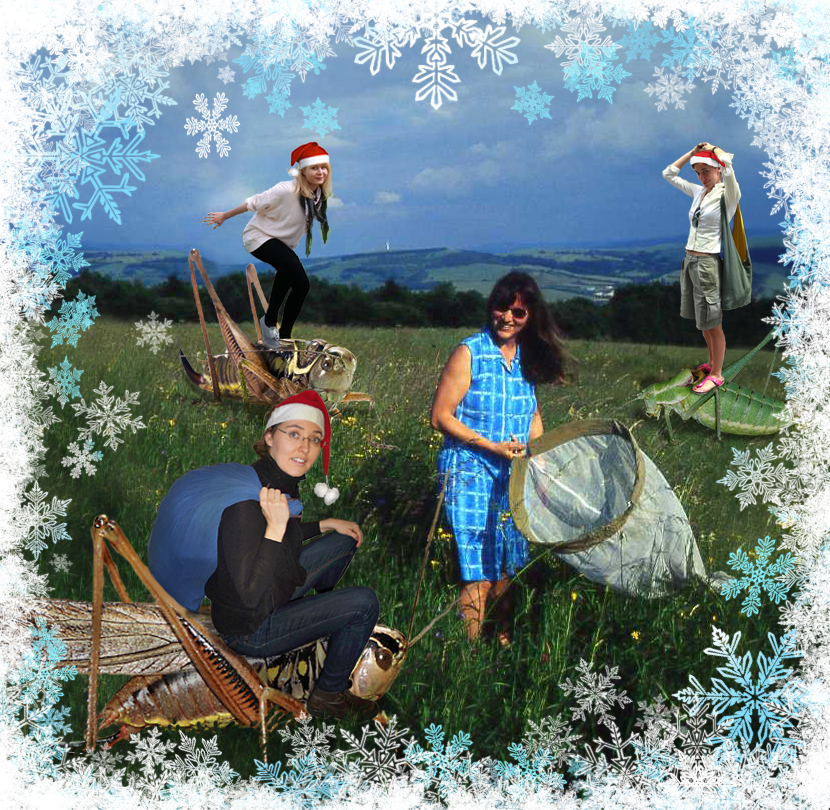 Our working group Decembre, 2014
Our working group Decembre, 2014
Students
(27) Dominic Hagg (2023): Analysis of historical stable isotope records to track a migration bird - the European barn swallow (Hirundo rustica). Humboldt Universität zu Berlin, Bachelor thesis (Second reviewer).
(26) Aleksandr Geld (2023): Die Bedeutung von Citizen Science-Daten für Naturschutzbehörden in Deutschland. Humboldt Universität zu Berlin, Bachelor thesis (Second reviewer).
(25) Lisa Maczkowicz (2023): Wie lernen Ameisen, sich zu erkennen? Dufthabituation von Ameisen und damit verbundene Verhaltensänderungen. Humboldt Universität zu Berlin, Bachelor thesis (Second reviewer).
(24) Tilo Michaelis (2023): Bestandsentwicklung der Braunkehlchenpopulation in Deutschland (über zwei Dekaden) basierend auf Citizen Science Daten. Humboldt Universität zu Berlin, Bachelor thesis.
(23) Daniel Doruch (2023): Bestandsentwicklung von Hummeln und ihren Kuckucksarten anhand von Citizen Science Beobachtungen auf naturgucker. Humboldt Universität zu Berlin, Bachelor thesis.
(22) Carina Ohlrogge (2022): Heuschrecken-Monitoring im Naturschutzgebiet Geesower Hügel. Humboldt Universität zu Berlin, Master thesis.
(21) Denise Jäckel (2022): Nutzbarkeit von Citizen Science für die Bioakustik am Beispiel der Nachtigall. Humboldt Universität zu Berlin, Doctoral thesis. Published as Jäckel et al. 2022a, 2023a
(20) Julia Rostin (2021): Citizen Science und die biologische Vielfalt in Berlin. Humboldt Universität zu Berlin, Bachelor thesis (Second Reviewer).
(19) Sandra Ahrens (2021): Die Differenzierung der Arten der Chorthippus biguttulus-Gruppe (Orthoptera: Acricidae) anhand morphologischer Merkmale. Humboldt Universität zu Berlin, Bachelor thesis.
(18) Nadja Wulff (2019): Untersuchungen zum stimulatorischen Potential der internen Genitalien bei Laubheuschrecken am Beispiel von Metrioptera roeselii (Orthoptera: Tettigoniidae). Humboldt-Universität zu Berlin, Doctoral thesis. Published as Wulff et al. 2017, 2018, Wulff & Lehmann 2020
(17) Marianna Anichini (2019): To be “Pavarotti” in a crowded concert hall? Song competition between male bushcrickets in natural choruses. Humboldt-Universität zu Berlin, Doctoral thesis. Published as Anichini et al. 2017, 2018, 2019, Rebrina et al. 2020
(16) Eileen Wallenhauer (2018): Riss-Statistiken beim Wolf Canis lupus. Humboldt-Universität zu Berlin, Master thesis.
(15) Juline Cibis (2017): Automatical behaviour classification by the use of acceleration-measurements (E-Obs) in hedgehogs. Humboldt-Universität zu Berlin, Master thesis (Second Reviewer).
(14) Lena Assmann (2017): Habitatansprüche ausgewählter xerophiler Heuschreckenarten auf dem ehemaligen Truppenübungsplatz Trampe - mit Schutzvorschlägen. Hochschule für nachhaltige Entwicklung Eberswalde, Bachelor thesis (Second Reviewer).
(13) Frederike Büttner (2016): Abundanz und Populationsökologie von Kleinsäugern im Havelland, Humboldt-Universität zu Berlin, Bachelor thesis (Second Reviewer).
(12) Sina Kuchenreuther (2015): Trade off zwischen Dispersion und Hören bei der Laubheuschrecke Metrioptera roeselii (Orthoptera: Tettigoniidae). Humboldt-Universität zu Berlin, Master thesis.
(11) Rene Mai (2015): Paarungsdauer bei Letana inflata: beeinflußt durch mate guarding oder Titillatoren? Humboldt-Universität zu Berlin, Bachelor thesis. Published as Lehmann et al. 2016
(10) Freya Weinert (2014): Vorkommen von Kleinsäugern auf unterschiedlichen Agrarflächen im NSG Havelländisches Luch. Humboldt-Universität zu Berlin, Diploma thesis (Second Reviewer).
(9) Martina Koch (2014): Bioakustisches Monitoring von Vogelgemeinschaften. Humboldt-Universität zu Berlin, Doctoral thesis (Second Reviewer).
(8) Anne Polz (2014): Körpermaße bei der flügeldimorphen Dornschrecke Tetrix subulata (Orthoptera: Tetrigidae). Humboldt-Universität zu Berlin, Master thesis.
(7) Sina Kuchenreuther (2014): Der Einfluss von Titillatorlänge und Körpermasse auf den Paarungserfolg bei der Laubheuschrecke Metrioptera roeselii (Orthoptera: Tettigoniidae). Humboldt-Universität zu Berlin, Bachelor thesis. – Published as Lehmann et al. 2021a
(6) Nadja Wulff (2013): The function of genital titillators during mating in bushcrickets. Humboldt-Universität zu Berlin, Master thesis. – Published as Wulff et al. (2015) and Wulff & Lehmann (2014, 2016)
Awarded the Katharina-Heinroth-Preis 2014 for her Master thesis.
(5) Anna Erzberger (2010): Using stable hydrogen isotope analysis to estimate altitudinal migration of bats in Cusuco National Park Honduras. Humboldt Universität zu Berlin, Bachelor thesis (Second Reviewer). – Published as Erzberger et al. (2012)
(4) Katja Jaszkowiak (2010): Balancierter Farbpolymorphismus bei der Feldheuschrecke Chorthippus dorsatus. Humboldt Universität zu Berlin, Bachelor thesis.
(3) Anja Portsch (2010): Paarungsverhalten unterschiedlicher Flügelmorphen der Dornschrecke Tetrix subulata unter der Annahme eines Dispersal versus Reproduction trade offs. Freie Universität Berlin, Diploma thesis. – Published as Steenman et al. (2013) and Steenman et al. (2015)
(2) Eva Schultner (2008): The biology and ecology of a rare specialist: Arcyptera brevipennis vicheti Brunner, 1861 (Acrididae, Orthoptera). Freie Universität Berlin, Diploma thesis (Second Reviewer). – Published as Schultner et al. (2012)
(1) Frederik Steinmetz (2007): Untersuchung einer neuen Heteropoda-Spezies anhand von Morphologie, Ökologie und Paarungsverhalten (Araneae: Sparassidae: Heteropodinae). Freie Universität Berlin, Diploma thesis (Second Reviewer).
![]()
![]()